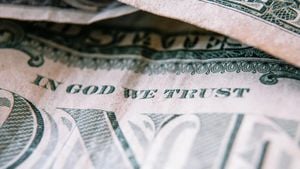A $6 million banana?! Yeah, you read it right! This bewildering price tag belongs to art piece "Comedian" by Italian artist Maurizio Cattelan, which features, quite literally, a banana taped to the wall with silver duct tape. It made headlines as it recently sold for $6.2 million at Sotheby’s auction house, sparking debates about the true value of art and what qualifies as artistic expression.
Originally unveiled at the 2019 Art Basel fair, "Comedian" was sold for $120,000, but interest and intrigue around the fruit have only escalated since then. The current buyer, Justin Sun, the founder of the cryptocurrency Tron, outbid six rivals to acquire the piece, which had initially started bidding at $800,000. His reasoning behind the hefty purchase? To him, the banana transcends mere fruit; it symbolizes the intersection of art, meme culture, and the crypto space.
Sun views the work as conceptual art meant to engage audiences on what defines value. He stated, “I believe this piece will inspire more thought and discussion in the future and will become part of history.” For this crypto mogul, buying the banana wasn’t just about ownership; it was about making a statement, and soon after his purchase, the value of Tron surged by 10%, indicating the buzz around the art piece did wonders for his coin’s credibility.
While some may chuckle at the idea of paying exorbitant sums for something as mundane as fruit, they might want to look closer at why such unusual art pieces carry their value. Often, the valuation of artwork stems not just from the piece itself, but the narrative behind it—the artist's fame, the rarity, and, frequently, the outrageousness of the work. By challenging traditional norms, Cattelan’s work forces viewers to reconsider what constitutes value today.
Interestingly, art speculation is not new. Higher prices often raise eyebrows, only to be followed by insightful discussions on the principles of art and value. The function of pieces such as "Comedian" juxtaposes traditional forms of valued art against contemporary, sometimes absurd creations. Critics argue whether the piece is absurdity at its pinnacle or genius boldness, contributing to the debate surrounding the value proposition of modern art.
But let's be real: There's more lurking beneath the surface of high-priced art sales. The dilemma of money laundering is one factor often associated with art auctions. Art markets often escape rigorous scrutiny, making them perfect playgrounds for dubious transactions involving illicit funds. The price of art tends to fluctuate based purely on subjective determinants which can complicate price validation, helping buyers utilize art as tools to obscure the source of wealth.
There are clearer examples illustrating how paintings and sculptures work as vehicles for hidden wealth. Auction houses sometimes conceal buyer identities, protecting the anonymity of the buyers and sellers alike. Hence, higher-priced art pieces can serve as effective assets for laundering money. This murkiness is prompting nations to implement stricter controls to avoid art sales being utilized for dubious financial practices. Countries like Mexico have already witnessed drastic declines in sales after implementing transparency laws.
Returning to Sun’s purchase of "Comedian", the odyssey of this banana does not end with its sale. What some are left pondering is not only about the price but about its actual longevity, as the banana itself will eventually rot. This unique art piece includes instructions on how to maintain it, requiring the banana to be replaced periodically, which only heightens the conversation around what art means over time.
After all, art is as much about experience as it is about physical presence. The fact is, collectible art has moved past static visuals and leaned progressively toward movements and ideas. Cattelan’s work, now owned by Sun, could become part of pop culture’s canvas, appealing to those who love auction spectacle, meme culture, and unconventional narratives.
Determining whether it’s absurd or genius truly lies with the beholder's viewpoint. Art, like any investment, hinges on appreciation over time — not just financially but intellectually. Sun plans to eat the banana, adding yet another bizarre twist to this peculiar tale, and as he stated on social media: “I will personally eat the banana as part of this unique artistic experience.”
Where do we draw the line on art and value? If art can come from literally duct-taping fruit to the wall, what does this say about the future of expression and its commodification? The question isn’t just philosophical but societal, putting the pulse on artistic integrity and contemporary commentary.
Let’s face it: the world’s art sphere always fluttered between the lines of esteem and incredible critique. Cattelan's unexpected choice to spotlight consumer products raises eyebrows and ignites conversation on what is worth placing on display. Perhaps, as the market for NFTs and digital collectibles continues to evolve, throwing dollar amounts at duct-taped produce might evolve too.
When we think of the bizarre trajectories this banana has traveled — from fruit stand to one of the most talked-about pieces at auction — we might realize: sometimes the stories behind artworks can be as valuable as the works themselves. Only time will tell if bringing absurdity to such heights pays off significantly down the line or leads the world to new notions about the value and perception of artistry as we know it.



